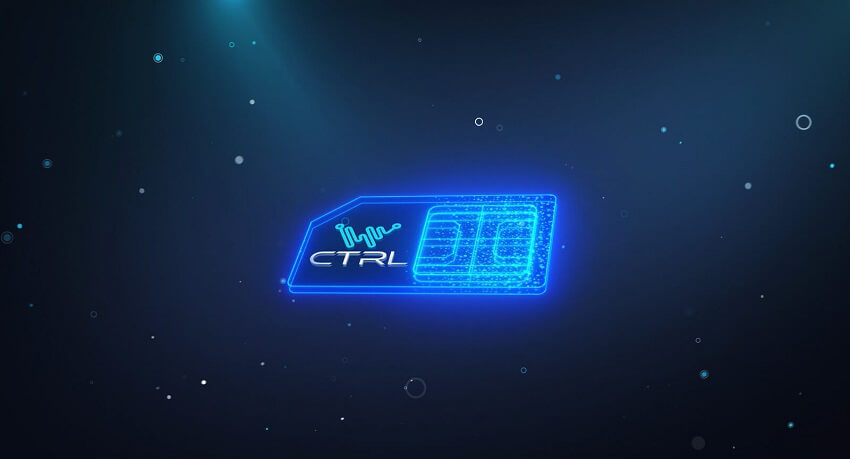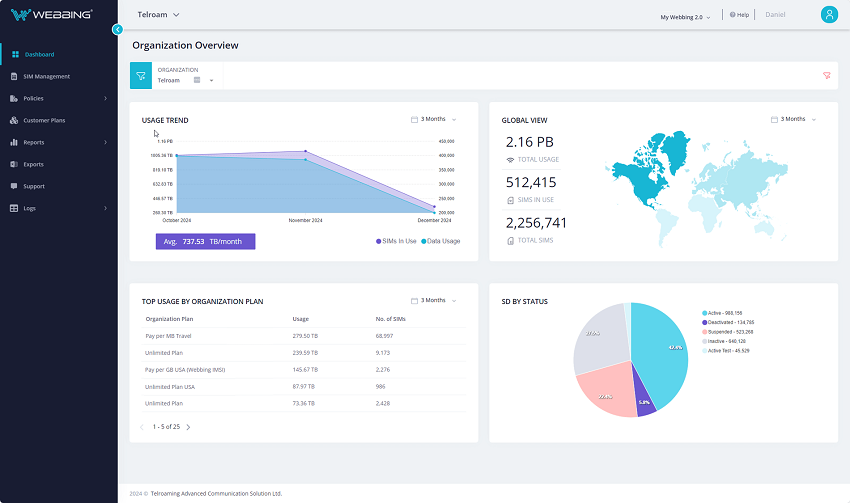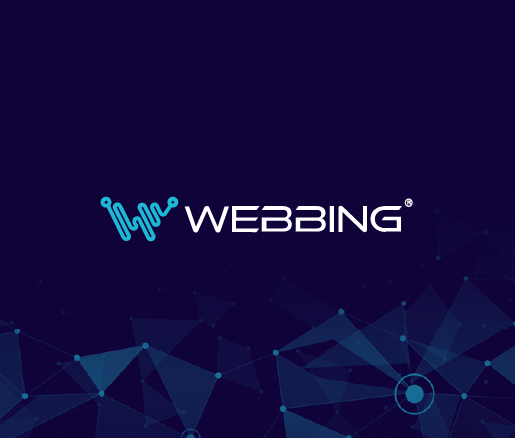by Webbing Team
In the 15 years since Webbing was founded, the landscape of cellular connectivity has evolved significantly. However, our commitment to leading the evolution of sustainable global data connectivity through innovative, high-quality, and scalable technology has remained unchanged. We are continuously redefining global connectivity, pushing industry boundaries to shift the power from the telecom industry to device owners where it should be.
To highlight our journey, here are 10 key facts about our solutions, technologies, projects, and customers that best reflect our growth and achievements.
-
Webbing provides multi-carrier connectivity worldwide
Cellular networks are one of the most effective ways to achieve global connectivity, offering wide coverage, seamless interoperability, scalability, reliability, and security for both enterprise mobility and IoT deployments. However, managing contracts with multiple carriers across regions can be complex and time-consuming.
We offer global cellular connectivity services that ensure access to reliable and high-quality internet worldwide without the hassle of contracting multiple operators. Webbing provides a secure and continuous internet connection, delivering a streamlined, centralized, and scalable means of deploying, controlling and monitoring all kinds of devices at any location with a single SIM.
Webbing has built a global partner network that spans over 600 carriers across more than 190 countries and territories. It guarantees worldwide coverage and allows to roam on several carriers’ networks in every region, solving the problem of weak spots that any mobile network may have and ensuring full coverage and continuous connectivity even at remote locations.

-
More than 1 million Webbing eSIMs have been deployed globally
While eSIM technology has made significant advancements and offered significant benefits to IoT, two initial GSMA remote SIM provisioning standards – M2M and Consumer – were not ideal for IoT adoption. Later, this prompted the GSMA to develop the new SGP.32 IoT Provisioning Standard.
However, when the first Consumer remote provisioning specifications were published, Webbing recognized its advantages over the M2M standard and began working on a solution tailored to IoT. In April 2022, Webbing launched WebbingCTRL, a pre-standard eSIM remote provisioning solution that adapted the Consumer architecture for IoT devices without user interfaces. Since then, over 1 million WebbingCTRL SIMs have been deployed all over the world.
WebbingCTRL enables organizations to remotely add, remove, and swap operators for any number of IoT deployments without operator integration or collaboration. It also provides a centralized way to manage eSIMs and profile inventory, as well as visibility into device data usage. Companies can set up business rules that would allow devices to change the serving Operator automatically under specific conditions, such as location, country, loss of connectivity or even after a certain amount of time.
WebbingCTRL is fully aligned with the GSMA SGP.32 specification and supports the new IoT standard.

-
Webbing was the first to offer a connectivity solution for full data localization in Turkey
Most countries in the world have regulations on connectivity, data sovereignty, and data protection. These legislation acts directly impact IoT deployments, and depending on the use cases and the markets that certain devices are deployed to, there can be dozens of regulations to comply with, from bans on permanent roaming to industry-specific ones, like eCall. It can be especially critical in countries with stricter regulations, such as Turkey.
As a full MVNO that owns its distributed core network, Webbing can help to comply with all kinds of regulatory requirements, be it preventing traffic from leaving the country borders, using local IMSI or full localization. Technology and infrastructure-wise, Webbing is capable of forming any architecture required by local legislation. In collaboration with Protahub, Webbing managed to seamlessly localize IoT deployments in Turkey, overcoming connectivity restrictions. We were the first connectivity provider to achieve this milestone.
-
Webbing offers tailor-made connectivity for every customer
We offer bespoke data plans tailored to each customer’s IoT deployment and use case. Whether it’s per MB/GB, pooled plans, or unlimited enterprise mobility packages, we design flexible solutions to match device types, usage patterns, and deployment locations, optimizing total cost of ownership.
Our plans come with advanced features like on-demand usage controls and content filtering, and we never throttle data, giving customers full control over their connectivity.

-
Webbing’s robust management platform is developed with customers’ needs in mind
Our connectivity management platform allows customers to configure and control data connectivity for their global fleet of devices. With over 15 years of in-house development and real-world use, it offers robust features for monitoring, optimizing data usage, managing support cases, accessing analytics, and more.
Unlike many “one-size-fits-all” solutions, our platform was built with a customer-first mindset — every feature is purposefully designed to address real-world use cases and specific operational needs. Because we fully own and operate the platform, we have the agility to continuously enhance it with custom features tailored to our customers’ evolving requirements.
-
Webbing’s core network has data centers on every continent
Many critical connectivity features depend on the core network — its architecture, components, technologies, and the network solutions in use. It affects latency, bandwidth, scalability, and ultimately determines how future-proof your IoT deployments are. However, ensuring that your connectivity provider owns critical infrastructure and supports your current usage scenarios may not be enough. The network may also require constant upgrades to keep pace with increasing data traffic, evolving regulations, security demands, and the need for cost-efficiency and scalability.
Webbing is a full MVNO that owns all core network elements. We have built a fully redundant distributed core network infrastructure with data centers all over the world. It is critically important, for example, for latency, since whenever a roaming IoT device sends data using a cellular connection, the data travels all the way to the connectivity provider’s data center before going to its destination. Last year, we added three data centers in UAE, Japan and Australia, which helped us improve latency and bandwidth in relevant regions. We also increased the capacity of our data centers in the United States and Netherlands, expanded our connectivity services to include voice communications, and improved our network resiliency and uptime. This year, we plan to open two more data centers in strategic locations.

-
For Webbing, providing IoT connectivity is not just selling SIM cards
Every IoT project that relies on cellular connectivity, regardless of locations or device type used, should begin with a comprehensive onboarding process from a trusted connectivity provider.
At Webbing, onboarding means more than activating SIMs. We build a dedicated team to deeply understand each customer’s unique use case. The process begins with device testing, KPI alignment, and seamless remote or on-site onboarding to ensure full integration. From there, we tailor connectivity solutions—including custom data plans and device management via our platform—to fit specific needs.
Our Customer Success Managers provide ongoing, hands-on support, enabling smooth scaling and real-time adaptation as requirements evolve. This personalized approach ensures not just a successful deployment, but a long-term partnership focused on both technical and business outcomes.
We believe IoT connectivity is not about selling SIM cards — it’s about building lasting relationships. The success of any IoT deployment depends on our ability to understand, adapt, and support from day one. Onboarding is the first and most critical step in ensuring everything works as intended, optimizing the total cost of operations, and maintaining long-term operational efficiency.
-
Webbing’s eSIMs connected almost 1900 devices for broadcasting events and competitions at the Paris Olympics
From July 26th to August 11th, 2024, Webbing’s core network transmitted about 30 terabytes of broadcasting data captured at the Olympic Games. It wasn’t the first major sports event that Webbing’s solutions helped to broadcast. Our eSIMs have supported seamless live broadcasting at several global events, including the 2022 FIFA World Cup in Qatar, the 2023 FIFA Women’s World Cup in Australia and New Zealand, and at the Professional Squash Association Global Tour 2024. Webbing’s eSIMs were used in mobile bonding devices that combine available cellular signals to provide better connection stability and more bandwidth, ensuring a smoother broadcast and seamless broadcasting operations.
Webbing also provided robust connectivity for complex, multi-location events such as the 2023 G20 Summit in India, which spanned 60 cities nationwide, showcasing the reliability and scalability of our global solution under demanding and dynamic conditions.

-
Webbing’s connectivity is crucial for connected cars
Our solutions help electric vehicle manufacturers overcome their connectivity problems and reduce time to market for global deployments, providing the benefits of roaming with multiple carrier options in every country, and seamless transition between carriers, while maintaining low rates and low latency on a global scale.
Webbing’s robust connectivity is a key enabler of connected car technology, delivering critical functionality across multiple areas. It supports continuous vehicle optimization through reliable Over-the-Air (OTA) updates, while enabling real-time diagnostics and predictive maintenance—improving vehicle safety, performance, and reliability with live monitoring and alerts.
Webbing also enhances the driver and passenger experience by powering high-speed access to in-car infotainment, navigation, and cloud-based services. Additionally, our global coverage supports Emergency Call (eCall) functionality, providing rapid response capabilities for enhanced road safety anywhere in the world.
-
Webbing’s connectivity solutions support mission-critical use cases
Webbing’s distributed core network, with local breakouts, multiple network solutions, and data server redundancy, ensures stable connections, high data throughput, and low latency across all devices. This makes Webbing’s IoT network ideal for supporting mission-critical, high-data consumption use cases.
With Webbing’s connectivity solutions, a single SIM can provide seamless multi-network access within a region, ensuring uninterrupted operation even in the most challenging environments. This level of reliability is crucial for disaster response, where communications infrastructure is often compromised and time is critical. Additionally, Webbing’s SIMs are used in various mission-critical security applications, such as off-grid mobile surveillance trailers and body worn cameras, providing reliable connectivity in demanding scenarios.
After 15 years in the industry, Webbing remains a pioneer in connectivity technology, delivering advanced connectivity solutions designed to meet the unique demands of customers across various sectors.
Reach out to learn how we can help you overcome connectivity challenges, reduce costs and deploy smarter, more efficient IoT solutions




